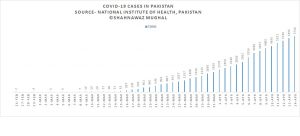The Covid-19 or as Novel Coronavirus which originated from Wuhan in December 2019 has converted the hospitals worldwide into a war zone. In past three months it has infected people in close to 213 Countries, territories or areas. As of now 1,44,243 lives have been lost and 21,58,250 getting infected[1]. The World Health Organization declared it as a pandemic on 11 March 2020.[2] In the South Asian region Nepal confirmed its first case of infection on 24 January[3]. Pakistan’s seriousness has been subject to criticism due to Prime Minister Imran Khan’s delayed response which lead to escalation of infected people.
Pakistan with its close ally China and shares a border with Iran which are among the top ten countries infected with COVID-19. Pakistan’s Federal Health Minister Zafar Mirza confirmed first two cases of Coronavirus on 26 February 2020[4]. Since then cases have increased exponentially and a high surge has been seen in last three weeks.

Prime Minister Imran Khan’s first address to the nation was on 22 March 2020 when there were already more than 800 confirmed cases. This address was aimed to “express views on challenges posed by the COVID-19 Pandemic”.[5] His reluctance to announce a nationwide lockdown citing economic reasons irked the all-powerful Army. On 23 March 2020, DG ISPR Major General Babar Iftikhar announced deployment of troops and suspension of International flights till April 4. This was done at the request of Interior Ministry to aid the civil administration under Article 245 of the Constitution.[6] Prime Minister Imran Khan’s second address to the nation on 30 March was criticised by Opposition as disappointing and a mere public relation exercise. PM cited ‘power of faith’ to fight the pandemic.
The spread of Coronavirus in Pakistan can be linked to two major causes. The former being the mishandling of pilgrims from Iran and latter being the congregational gatherings. The negligence of the government in proper screening and quarantine of pilgrims arriving from Iran led to a surge in infections. The immigration documents accessed by Arab News reveal that since Early February to 26 March around 6080 pilgrims arrived in the border city of Tuftan, Baluchistan. Pakistan officially closed its 956 km long border with Iran on March 16.[7]Although this did not stop the pilgrim arrival from Iran. It is evident that the government did not exercise its diplomatic privileges in convincing the Iranian counterparts to stop sending the pilgrims back when the border was officially closed. They were put up in unhygienic conditions. A report by Al Jazeera on 23 March displayed inadequate screening for people showing symptoms surfaced. Makeshift camps lacked hygienic food, proper toilets, sanitary and medical facilities. Although the government denied such claims.[8] Many among them left the camps and went further into their home provinces.
Punjab where the General Headquarters of the Army are located has seen the highest number of coronavirus infections. Reports surfaced that the positive patients from the province were being moved to Gilgit Baltistan and PoK area. This was done as the bigwigs in the Army did not want any positive patient near the Army facilities and family housing.[9] The death of Dr. Usman Riaz who was active in treatment of pilgrims in Gilgit Baltistan region is also linked to pilgrims returning from Iran.
Large Congregational gatherings in Pakistan also became an important factor in the spread of virus. Lahore Ijtima of Tableeghi Jamat was organized on 11-13 March which was initially planned till 15 March. An estimated 250,000 people attended the event. It is important to note that when the event was called off on 13 March the reason given was ‘bad weather’ and not a global pandemic.[10]A cleric Asif Ashraf Jalali vowed to organize a conference personally guaranteeing the safety of attendees. He further said that he should be hanged even if one case of coronavirus is found. Yet another well-known cleric Zameer Naqvi declared that he has a cure for coronavirus but won’t tell as the government was not serious.[11] Even the Friday congregational prayers were banned only on April 3 when there were 2700 confirmed cases in the country. Thus, Government’s submission to clerics in an effort to keep them on their side resulted in nationwide spread of the virus.
The country already facing a debt crisis did not respond responsibly to the SAARC virtual meeting called by the Indian Prime Minister on 15 March 2020. Pakistani Health Minister Zafar Mirza needlessly raised the Kashmir issue when the agenda of the meeting was to increase regional cooperation to tackle the pandemic. Moreover it boycotted the follow up meeting of SAARC trade officials on 8 April 2020[12]. On 13 April 2020, it committed a ceasefire violation in the Kupwara region along the Line of Control. 3 civilians including a minor died and many fled their homes due to heavy shelling from across the border.[13] Pakistan should realize that such petty acts would only jeopardize its efforts in fighting the deadly virus.
Pakistan’s healthcare expenditure is 2.9 % of its GDP (2017), in contrast to the World Health Organization’s observation of 5% yearly. Money is scarce and a large chunk of the National Budget is taken away by the Army. Shortage of medical facilities, critical care equipment, protective gear has created hindrances in the fight against the pandemic. In Quetta dozens of doctors were arrested on 7 April for protesting against the lack of Personal Protective Equipment (PPE).[14] Punjab has 3276 active cases and currently amounts to half the cases across Pakistan. The situation in Sindh is no better with 2008 active cases. The resource crunch in an economy which is already in a downward spiral has made it difficult for the government to cope with the disease. It has asked for a loan of $3.7 billion from different multilateral creditors to deal with the economic crisis emerging from Coronavirus.[15]
CONCLUSION
Pakistan historically has been ruled by a Clergy-Army nexus. Present government’s submission to this nexus in the wake of a health emergency has led to the spread of this pandemic as cases are rapidly increasing. The reluctance to call for a nationwide lockdown resulted in mass gatherings across Pakistan. Further the mishandling of pilgrims coming back from Iran led to a situation which was unmanageable. It should be accepted that the Pakistan government was pointless in dealing with an emergency that required a high priority response. Country’s poor healthcare system has only added to the increasing woes. Cases are increasing every day and an extended lockdown will only deplete the state’s resources. It’s trifling response to SAARC meetings and escalating the tensions at LoC in no way will help to contain the disease. Prime Minister Imran Khan has a humongous challenge to save the Awaam from the deadly virus and uplift the sinking economy. Religion and nationalism can boost morale, but it requires concentrated state policy and coordinated decisions to handle a crisis.
End Notes:
[1] As per the data from WHO website, https://www.who.int/emergencies/diseases/novel-coronavirus-2019, (Accessed on 12/04/20)
[2] ibid
[3] Nepal confirms first case of deadly coronavirus, January 24,2020, https://economictimes.indiatimes.com/news/international/world-news/nepal-confirms-first-case-of-deadly-coronavirus/articleshow/73590302.cms (Accessed on 12/04/20)
[4] Pakistan confirms its first two cases of coronavirus, February 26,2020 https://economictimes.indiatimes.com/news/international/world-news/pakistan-confirms-its-first-two-cases-of-coronavirus/articleshow/74324611.cms (Accessed on 12/04/20)
[5]Pakistan to address the nation tonight to address challenges posed by the coronavirus, 22 March,2020 https://nation.com.pk/22-Mar-2020/pm-to-address-nation-tonight-on-challenges-faced-by (Accessed on 13/04/20)
[6] Army called in to fight pandemic, Kamran Yousuf, The Tribune, 24 March 2020, https://tribune.com.pk/story/2182804/1-army-called-fight-pandemic/ (Accessed on 15/04/20)
[7] Hundreds enter Pakistan from Iran despite border closure, Baker Atyani Naimat Khan, Arab News, 29 March 2020, https://www.arabnews.com/node/1649091/world (Accessed on 12/04/20)
[8] Coronavirus: Inside Pakistan’s Taftan Quarantine Camp, Al Jazeera, 23 March 2020, https://www.aljazeera.com/programmes/newsfeed/2020/03/coronavirus-pakistan-taftan-quarantine-camp-200323110255493.html (Accessed on 15/04/20)
[9] Pak Army forcibly moving COVID-19 positive patients to POK and Gilgit, 26 March 2020, https://www.aninews.in/news/world/asia/pakistan-army-forcibly-moving-covid-19-positive-patients-to-pok-and-gilgit20200326143210/ (Accessed on 17/04/20)
[10] How Pakistan became a Coronavirus super spreader to the entire Muslim world, Kunwar Khuldune Shahid, 27 March 2020, https://www.haaretz.com/opinion/.premium-how-pakistan-became-a-coronavirus-super-spreader-to-the-muslim-world-1.8708783 (Accessed on 17/04/20)
[11] Why Pakistan is the most chilled out in a world hit by coronavirus, Naila Inayat, The Print, 19 March 2020, https://theprint.in/opinion/letter-from-pakistan/why-pakistan-is-the-most-chilled-out-in-a-world-hit-by-coronavirus/383458/
[12] Pakistan boycotts India led meeting of SAARC trade officials on coronavirus crisis, 9 April 2020, https://www.indiatoday.in/world/story/pakistan-boycotts-india-led-meeting-saarc-trade-officials-coronavirus-crisis-1664904-2020-04-09 (Accessed on 17/04/20)
[13] Amid Coronavirus lockdown, LoC continues to be war zone, Abhishek Bhalla, India Today,13 April 2020, https://www.indiatoday.in/india/story/amid-coronavirus-lockdown-loc-continues-to-be-war-zone-1666401-2020-04-13 (Accessed on 15/04/20)
[14] Pakistan arrests doctors protesting over lack of virus safety equipment, The Guardian, 7 April 2020, https://www.theguardian.com/world/2020/apr/06/pakistan-arrests-doctors-protest-lack-coronavirus-safety-equipment (Accessed on 16/04/20)
[15] Pakistan asks USD 3.7 billion loan as coronavirus cases rise to 1200, India Today, 27 March, https://www.indiatoday.in/coronavirus-outbreak/story/pakistan-seeks-usd-3-7-billion-loan-as-coronavirus-cases-rise-to-nearly-1-200-1660164-2020-03-27 (Accessed on 12/04/20)














